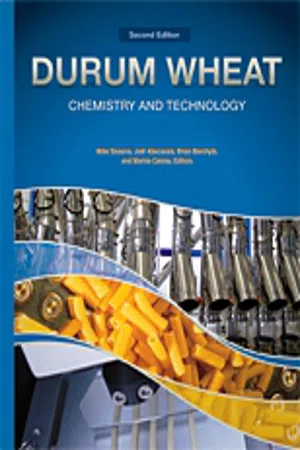
- English
- ePUB (mobile friendly)
- Available on iOS & Android
Durum Wheat Chemistry and Technology
About This Book
The most extensive and comprehensive reference on durum wheat chemistry and technology ever available, this ambitious update to the first edition covers more diverse and interesting topics in a new expanded format. Forty-six contributors, each highly experienced and recognized as world authorities on durum wheat, provide the latest developments in scientific research and technology. All aspects of durum wheat are covered, from agronomy and the chemical composition of the grain, to the latest industrial approaches to processing durum wheat, as well as food safety and quality assurance issues. Expanded to include new topics like functional pasta, grain safety, and biotechnology, along with practical and applied information including a table of uses for specific carbohydrates, descriptions of improved laboratory techniques, and international comparisons of HACCP experiences, Durum Wheat: Chemistry and Technology, Second Edition is a must-have reference for professionals, students, and researchers inside and outside the field who want to learn about durum wheat technology and chemistry.
New and Revised Topics Include:
- Agronomy of durum wheat production
- Pasta made from non-traditional raw materials: technological and nutritional aspects
- Grain safety assurance, including impacts on durum wheat trading
- Origin and distribution of durum wheat genetic diversity in the world
- Genetics and breeding of durum wheat
- Insect and mite pests and diseases of durum wheat
- Kernel components of technological value
- Vitamins, minerals, and nutritional value of durum wheat
- Durum wheat milling
- Manufacture of pasta products
- Other traditional durum derived products
- Methods used to assess and predict quality of durum wheat, semolina, and pasta
- Grading factors impacting on durum wheat and processing quality
- Grain safety assurance including impacts on durum wheat trading
- Marketing perspectives in the durum wheat trade
Special Features:
- Detailed figures outlining the processes used to manufacture durum products
- International comparisons of HACCP experiences
- Table of uses for specific carbohydrates
- Descriptions of improved laboratory techniques
- Extensive bibliography
An Essential Reference For:
- Scientists and researchers in agriculture and plant biology
- Professionals in the food industry who are processing durum wheat (millers, pasta makers, grain handling companies, and grain buyers)
- Government regulators
- Food scientists and technologists developing products using durum wheat
- Plant breeders
- University lecturers in agricultural science and plant biology
- Professionals who market wheat
- Nutritionists and medical practitioners interested in the impacts of food ingredients on human healthStudents
- Scientific libraries and their patrons
Frequently asked questions
Information
Origin and Distribution of Durum Wheat Genetic Diversity in the World
EVOLUTION AND CLASSIFICATION OF WHEATS
A Common Ancestral Genome for Grasses
Polyploidization: A Common Evolutionary Feature in Triticeae
Classification of Wheats Within a Polyploid Series
Table of contents
- Cover image
- Title page
- Table of Contents
- Copyright
- Contributors
- Preface to the Second Edition
- Preface to the First Edition
- Chapter 1: Origin and Distribution of Durum Wheat Genetic Diversity in the World
- Chapter 2: Genetics and Breeding of Durum Wheat
- Chapter 3: Agronomy of Durum Wheat Production
- Chapter 4: Diseases of Durum Wheat
- Chapter 5: Insect and Mite Pests of Durum Wheat
- Chapter 6: Kernel Components of Technological Value
- Chapter 7: Vitamins, Minerals, and Nutritional Value of Durum Wheat
- Chapter 8: Durum Wheat Milling
- Chapter 9: Manufacture of Pasta Products
- Chapter 10: Other Traditional Durum-Derived Products
- Chapter 11: Pasta Made from Nontraditional Raw Materials: Technological and Nutritional Aspects
- Chapter 12: Methods Used to Assess and Predict Quality of Durum Wheat, Semolina, and Pasta
- Chapter 13: Grading Factors Impacting Durum Wheat Processing Quality
- Chapter 14: Grain Safety Assurance, Including Impacts on Durum Wheat Trading
- Chapter 15: Marketing Perspectives in the Durum Wheat Trade
- Index